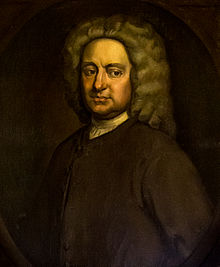William Greene (Colonial Governor)
William Greene (born March 16, 1695 in Warwick , Colony of Rhode Island and Providence Plantations , † February 22, 1758 in Providence , Colony of Rhode Island and Providence Plantations) was a British politician . He served as lieutenant governor for three years and as governor of the Colony of Rhode Island and Providence Plantations for eleven years.
Life
William Greene, son of Mary Gorton (1673-1732) and Samuel Greene (1671-1720), was during the reign of William III. Born in Kent County , which was then still part of Providence County . His grandfather was Lieutenant Governor John Greene junior . His father, John Greene senior , came from Salisbury in the county of Wiltshire in England . He was a surgeon ( Surgeon ) and an early settler in Warwick in New England . Samuel Gorton , William Greene's maternal great-grandfather, was the founder of Warwick and for a short time the colonial governor of the two towns of Providence and Warwick.
Nothing is known about William Greene's youth. Greene became a Freeman in 1718. At the age of 32, in 1727, he was elected MP for Warwick - a post he held for five years. Greene also served as a clerk at the Providence District Court. He was speaker in the General Assembly in 1734 and 1739 . In 1728 he and John Mumford from Newport were called upon to survey the boundary between the colonies of Rhode Island and Connecticut . When colonial governor John Wanton died in 1740, Richard Ward was his successor and Greene his new lieutenant governor. Greene held this post until his own election as colonial governor in May 1743. This was one of the rare occasions when the governor of Rhode Island was not from Aquidneck Island , where the towns of Newport and Portsmouth were located.
One of the most important concerns during his first term as colonial governor was the borderline of the colony. Several geographic boundaries have been adjusted. The towns of Barrington , Warren and Bristol were added to Bristol County and the towns of Tiverton and Little Compton to the towns on Aquidneck Island in Newport County . Another important point was the war against France and Spain . The colony was expected to take part in the defense of the crown. When England declared war on France on March 31, 1744, the colony manned forts and reinforced them with cannons and ammunition. With the support of Rhode Island troops, Commodore Warren besieged Louisbourg in Nova Scotia , which was surrendered in June. The Europeans were surprised:
"[The] strongest fortress of North America had capitulated to American farmers, machanics [sic], and fishermen."
The colony also had a few war slups alongside 15 privateers . They succeeded in capturing 20 ships during the war and bringing them to Newport.
During his third term in office, the colony was split into two warring camps. The leaders of these were both future colonial governors, Samuel Ward and Stephen Hopkins . Greene stood on Ward's side. Some of the points at issue were war versus peace, paper money versus hard currency, and Providence interests versus Newport interests. The camps were chosen alternately. In the midst of the argument stood Greene, who died in February 1758 during his fourth term in office.
family
Greene married his second cousin, Catharine Greene, daughter of Susanna Holden and Benjamin Greene, in 1743. She was the granddaughter of Randall Holden and great-granddaughter of John Greene senior. The couple had six children, five of whom reached adulthood. Her son, William Greene, Jr. was the second governor of Rhode Island after it became a state.
literature
- Austin, John Osborne: Genealogical Dictionary of Rhode Island, Albany, New York: J. Munsell's Sons, 1887, ISBN 978-0-8063-0006-1 , pp. 88, 302-305
- Bicknell, Thomas Williams: The History of the State of Rhode Island and Providence Plantations 3, New York: The American Historical Society, 1920, pp. 1068-1071.
- Turner, Henry Edward: Greenes of Warwick in Colonial History, Newport, Rhode Island: Davis & Pitman, Steam Printers, 1877, pp. 17f
Web links
- William Greene in the database of Find a Grave (English)
- William Greene on the NNDB website
- William Greene on the quahog.org website
- William Greene on the Rhode Island Historical Society website
Individual evidence
- ^ Mary Gorton Greene in the Find a Grave database . Accessed March 21, 2015.
- ^ Samuel Greene in the Find a Grave database . Accessed March 21, 2015.
| personal data | |
|---|---|
| SURNAME | Greene, William |
| BRIEF DESCRIPTION | British politician |
| DATE OF BIRTH | March 16, 1695 |
| PLACE OF BIRTH | Warwick , Rhode Island |
| DATE OF DEATH | February 22, 1758 |
| Place of death | Providence , Rhode Island |
